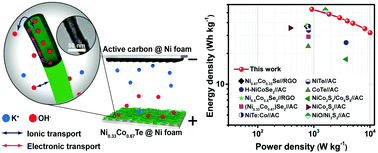Synthesis of novel bimetallic nickel cobalt telluride nanotubes on nickel foam for high-performance hybrid supercapacitors†
Abstract
To improve the energy density of a supercapacitor while maintaining its high power density, novel bimetallic nickel cobalt telluride nanotubes are synthesized on nickel foam by a facile solvothermal synthesis followed by an ion-exchange reaction for constructing self-standing hybrid supercapacitor electrodes with high specific capacity and electrical conductivity. The nickel cobalt nanosheets generated by solvothermal synthesis are converted to nickel cobalt telluride nanotubes during the ion-exchange reaction process in the presence of Na2TeO3 at 180 °C. The resultant Ni0.33Co0.67Te nanotubes with large aspect ratios and thin walls form a robust interpenetrating network on nickel foam, providing convenient ion/electron transport channels and accessible contact of the electrode with electrolyte. Benefiting from such a nanotubular structure, the Ni0.33Co0.67Te nanotube electrode delivers a high specific capacity of 131.2 mA h g−1 at 1 A g−1 and 79.3 mA h g−1 at 20 A g−1 with satisfactory cycling durability. Furthermore, the assembled Ni0.33Co0.67Te nanotube//active carbon hybrid supercapacitor achieves a high energy density of 54.0 W h kg−1 at a power density of 918 W kg−1, and a long-term cycling stability with 90% of capacity retention after 5000 cycles. This work provides a simple and efficient approach to produce bimetallic nickel cobalt telluride nanotube electrodes for high-performance hybrid supercapacitors.



 Please wait while we load your content...
Please wait while we load your content...